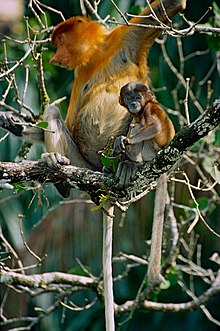Tn̂g-phīⁿ-kâu
Tn̂g-phīñ-kâu (proboscis monkey; long-nosed monkey; ha̍k-miâ: Nasalis larvatus; 長鼻猴) sī kâu-kho (cercopithecidae) tn̂g-phīñ-kâu sio̍k ē-kha uī-it ê tsi̍t-ê tsíng. Tn̂g-phīñ-kâu ê tsú-iàu ti̍k-ting tō sī i-ê tuā koh tn̂g ê phīñ-á. Phīñ-á ê iōng-tōo pīng m̄-sī tsiâñ tshing-tshóo, ū khó-lîng sī suán-ti̍k ê kiat-kó.[3]
| Tn̂g-phīñ-kâu | |
|---|---|

| |
| Kang-ê, Malaysia Borneo Sabah Labuk-uan | |

| |
| Bó-ê kah kâu-á-kiáñ, Malaysia Borneo Sarawak | |
| Kho-ha̍k hun-lūi | |
| Kài: | Animalia |
| Mn̂g: | Chordata |
| Kong: | Mammalia |
| Bo̍k: | Primates |
| A-bo̍k: | Haplorhini |
| Infraorder: | Simiiformes |
| Kho: | Cercopithecidae |
| Sio̍k: | Nasalis É. Geoffroy, 1812 |
| Chéng: | N. larvatus[1]
|
| Ha̍k-miâ | |
| Nasalis larvatus[1] Wurmb, 1787 | |

| |
Sing-bu̍t biâu-su̍t
siu-káiKang-kâu pí bó-kâu khah-tuā tsiâñ-tsē. It-puañ līn-uî tāi-iok 72-cm tn̂g, bué-tn̂g 75-cm, thé-tāng 24-kg. Bó-kâu kan-na ū 60-cm tn̂g, thé-tāng 12-kg.
Tn̂g-phiñ-kâu ê pak-tóo mā khah-tuā, i-ê siau-huà hē-thóng hun-tsò tsiâñ-tsē pōo-hūn; án-ne mā khah-ū pang-tsoo siau-huà i sóo-tsiah ê tshiū-hiō-á. Tsē mā-sī û-ít ê huat-hiān ē-tàng huan-tsháu (ruminant) ê lîng-tióng-luī tōng-bu̍t.[4] I-ê si̍t-bu̍t tû-liàu tshiū-hiō-á, mā-ū pau-kuat tsíng-tsí. M̄-kū, tn̂g-phīñ-kâu bē-sái tsia̍h tiñ ê mi̍h-á (in-uī uī-pōo tuì ba̋i-khín ū put-lī ê íng-hióng).
Tn̂g-phīñ-kâu kah Borneo âng-sing-sing (Bornean orangutan) ua̍h-ê kāng-tē-khu.[5] I-mā sio̍k-î tan-hîng (monotypic taxon) phīñ-kâu (Nasalis) ê tsi̍t-luī.[6]
Tē-lí hun-pòo
siu-káiTn̂g-phīñ-kâu tsú-iàu tshut-sán teh tang-lâm-a Borneo hái-kîñ ê âng-tshiū-nâ (mangrove) lāi-té, làm-tē tíng-kuân kah khe-huāñ ê tshiū-nâ lāi-té tíng-tíng ê sóo-tsai. Tn̂g-phīñ-kâu sī kûn-tsū ê tōng-bu̍t, ta̍k-kûn tāi-iok-á ū 10-20 tsiah ê kâu-á bô-it-tīng. [3]
Tsù-kái
siu-kái- ↑ Groves, C. P. (2005). "Order Primates". Chū Wilson, D. E.; Reeder, D. M. Mammal Species of the World: A Taxonomic and Geographic Reference (3rd pán.). Johns Hopkins University Press. pp. 168–169. ISBN 978-0-8018-8221-0. OCLC 62265494.
- ↑ Boonratana, R.; Cheyne, S.M.; Traeholt, C.; Nijman, V.; Supriatna, J. (2020). "Nasalis larvatus": e.T14352A17945165.
- ↑ 3.0 3.1 "Proboscis monkey". December 2019. 11 December 2019 khòaⁿ--ê.
- ↑ Murai T., Clauss M., Yamada T.,Tuuga A., Bernard H., Higashi S. (2011-03-30). "Regurgitation and remastication in the foregut-fermenting proboscis monkey (Nasalis larvatus)". Biology Letters. doi:10.1098/rsbl.2011.0197. 2011-04-01 khòaⁿ--ê.
- ↑ "Economics, Ecology and the Environment: "Conservation of the Proboscis Monkey and the Orangutan in Borneo: Comparative Issues and Economic Considerations"" (PDF). March 2007.
- ↑ Bradon-Jones D., Eudey A. A., Geissmann T., Groves C. P., Melnick D. J., Morales J. C., Shekelle M., Stewart C. B. (2004). "Asian primate classification". International Journal of Primatology. 25: 97–164. doi:10.1023/B:IJOP.0000014647.18720.32.
Tsham-ua̍t
siu-kái- Johns Hopkins tāi-ha̍k chhut-pán-siā (Johns Hopkins tāi-ha̍k tshut-pán-siā/Johns Hopkins University Press)
- Chō-chóa-su̍t (Tsō-tsuá-su̍t/Papermaking)
- Chheng-chhoan bo̍k-to̍k (Tsheng-tshuan bo̍k-to̍k/青川木牘)
- Behistun bêng-bûn (Behistun bîng-bûn/Behistun Inscription)
- Sagan piau-chún (Sagan piau-tsún; eng-gí: Sagan standard; hàn-gí: 薩根標準)
Guā-pōo lên-ket
siu-kái- ARKive – images and movies of the Proboscis monkey (Nasalis larvatus)
- Primate Info Net Nasalis Factsheets
- Save the Proboscis Monkeys Petition and weblog with info on the rare, endangered species.
- A Video about proboscis monkeys Archived 2020-11-14 at the Wayback Machine. by National Geographic
- John C. M. Sha, Ikki Matsuda & Henry Bernard (2011) The Natural History of the Proboscis Monkey
- John C. M. Sha, Henry Bernard, and Senthival Nathan (2008) Status and Conservation of Proboscis Monkeys in Sabah, East Malaysia
